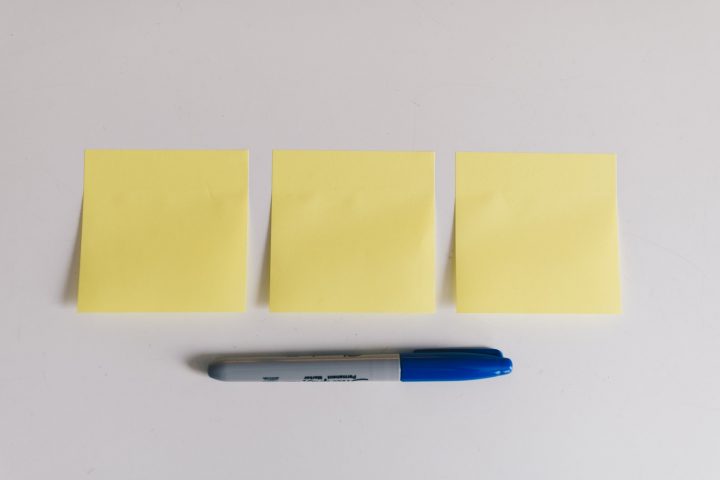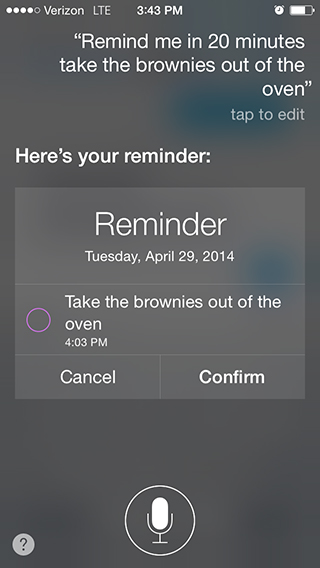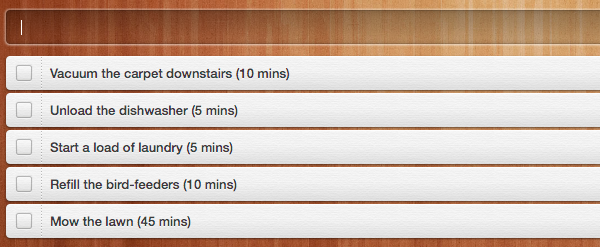
“God gave us memory so that we might have roses in December.”
J.M. Barrie
Most of us know how to tackle large tasks: You make a plan, set aside time, and execute. However, how do you make sure those little, pesky to-dos get done? Put new batteries in the camera. Call the bank about that letter. Pick up some milk while you’re out.
Small to-do tasks are easily forgotten because they just aren’t important enough to stay at the top of our minds. Memory research has shown that our short-term memory can hold about 5-9 thoughts at a given time, and those thoughts are forgotten after about ten seconds to a minute. For example, you have to store the beginning of this sentence in short-term memory for the end of it to make sense, but by now you’ve probably forgotten the first sentence of this blog post.
Short-term memory can theoretically be refreshed indefinitely if we keep repeating the task to ourselves, for example: “remember the milk, remember the milk, remember the milk” we say to ourselves as we walk out the door. However, as soon as we get distracted by that guy who cuts us off as we head towards the market and start thinking about how we would never drive that way and how we bet he’s an idiot in all other areas of his life…we are close to forgetting about the milk if we haven’t already.
Thankfully, triggers bring back short-term memory, so after you calm down about being cut off, and you find yourself driving down Main Street, within a split second you unconsciously ask yourself “Where am I going?”, and within an instant, the milk re-enters the short-term memory.
So how do we remember all of the small tasks that we need to accomplish in our lives?
Mental Chunks
If we’re relying on short-term memory alone, we can multiply our short-term reserves by chunking meaningful data (based on research by Herbert Simon). For example, put these three lists into short-term memory:
- January, February, March, April
- Red, White, Blue
- Lions, Tigers, Bears
Now close your eyes and try to remember these items.
Even though I’ve given you a cumulative 10 items to memorize, they only take up 3 of your short-term memory stores because they are chunked into meaningful groups. Ironically, they are easier to remember if I add more words to the chunks:
- Summer takes place during June, July, and August.
- Monday, Tuesday, Wednesday, Thursday, Friday are weekdays.
- For breakfast I eat milk and cereal.
The reason why the second group should be easier to remember is that the listed items are already associated with three existing concepts: Summer, weekdays, and breakfast. If we can remember these 3 things we can remember all 10 on the list.
So how is this going to help us remember small to-do items? By thinking of an association for the to-do item, or chunking it into a group of things to do that are related. The only problem with this is that if we don’t write that association or chunk trigger down, or otherwise ensure that we will be reminded of it at the right time, we will forget about it as soon as we stop repeating it to ourselves (and it leaves short-term memory). That is usually not going to be acceptable, so the next few tips are ways to trust another system to trigger those tasks back into short-term memory when needed.
Use Your Phone’s Reminder Feature
When the iPhone 4S came out, it launched with a virtual assistant named Siri. While Siri can do all sorts of fun things like telling you the meaning of life, the virtual assistant can also quickly make reminders for you, and the phone will then alert you based upon that trigger. For example, here are some things that I might say to Siri throughout the day:
- Remind me when I get home to change the lightbulb in the basement.
- Remind me at 10:00 tomorrow morning to call the mechanic.
- Remind me when I leave work to go to Home Depot.
- Remind me in 20 minutes to turn off the sprinkler.
With location-based services and the built-in clock, you can use your phone to provide a powerful reminder system to trigger those thoughts back into your memory. A virtual assistant like Siri is also available in several other apps for both iPhone and Android.

Use a Google Calendar
In a previous post, I shared how I use Google Calendar to keep track of the day’s main priorities. In addition to this, you can use Google Calendar to reliably send notifications to yourself to remember important events. You can set up an event with a specific time, then tell it to text you or email you minutes, hours, or days beforehand. You can also combine multiple reminders for an event, like so:
- Text me 12 hours before my monthly breakfast with Sam (so when I am winding down for the evening I remember that breakfast is that next morning).
- Text me 1 hour before my monthly breakfast with Sam (in case I forgot about last night’s text, and start driving the other direction for work).
The power of this tool is the ability to have multiple reminders for the same event.

Create a List with the Approximate Time Needed to Complete Each Task
When you end up with a handful of small to-do tasks that can typically be squeezed in throughout the day, it can be beneficial to write these tasks down with a small notation of how long the task will take. For example, I am a lot more inclined to tackle a quick task when I see “5 mins” written next to it, as this is a reminder that I will be able to check it off my list in a short amount of time. If I have a list of 20 short tasks, I am more motivated to check off a few of them if times are written down as well because I see “three 5-minute tasks” that I can accomplish, and not a long list of things to do (which I would be tempted to put off until later).
Example:

Strategically Place a Trigger
We’ve already discussed how triggers bring an event back into your short-term memory. These triggers don’t have to be digital, like with Siri, but could be as simple as placing a visual reminder somewhere that you know will trigger the action at the right time. For example, right before leaving for vacation, I received a letter from our mortgage lender that I need to call and ask them about. I know that simply seeing that letter will trigger the need to make a phone call, so I placed the letter in a magazine that I knew I wanted to read. Sure enough, when I sat down to read the magazine by the pool, I saw the letter and made a quick call to the mortgage lender.
The trick with the visual trigger is that you have to be sure that it won’t get lost in a mess of other triggers, like if I were to place that letter in a pile of a bunch of other papers at my desk.
Conclusion
No matter which method (or combination of methods) you use for remembering small tasks, the important thing to remember is that we cannot trust our short-term memories for much longer than a minute without employing some form of a trigger to surface a reminder of our task. This, of course, takes some discipline and practice to become a habit…which is why next week we will talk about turning certain tasks into routines.
What are your thoughts on this? I’d love to hear about any experiences, tips, or questions in the comments below.